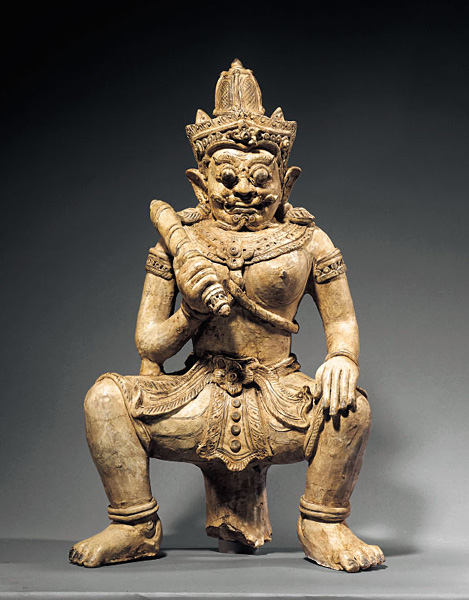|

Dvarapalas are guardians of doors and entrances of temples and other holy sanctuaries. Also known as Yakshas, they are the guardians of the earth treasures and were originally antigods (asuras). These �marvellous� and �mysterious� deities are associated with frightening away the evil spirits and are connected with the serpents (nagas). The guardians originated from the Raksasas (demons), benevolent beings who are living upon the earth or on its borders. They are powerful in battle and uproot trees, and hurl the tops of the mountains against their enemies. In addition they are skilled in magic and can transform themselves into all sorts of shapes, (human, animal or monstrous) and become invisible. With their bulging eyes, sharp protruding teeth and tongue of unusual length they always appear fearful and with an imposing strength. These guardians are the children of darkness who wander at night.
Seated in a European fashion with both feet pointed slightly to the sides, the dvarapala is portrayed with flaming bulging eyes, protruding teeth, and with pronounced eyebrows, beard and moustache. His raised right hand is holding a long club (gada), symbolising the power of knowledge, and a weapon of attack. His left hand rests on his left knee. The guardian is adorned with a crown, ear-ornaments, a necklace, bracelets, anklets, a dhoti and ornaments. The belt, necklace and crown bear the depiction of an open folded lotusflower, the symbol of the divine origin and the universe.
The tradition of Thai pottery began by craftsmen who migrated from South China and congregated in the 14th century at Sukhothai and Sawankhalok to pursue their craft, imparting their expertise to local potters. These were innovators intent on raising their craft to higher levels. As a result, they were continually trying out new shapes, designs and glazes. The Sukhothai sculptural ceramics (14th and 15th century) are among the finest ever produced by Thai artists, and are created as integral parts of monumental architecture. Some of the most intriguing are the guardians also known as �dvarapalas� or �raksasas�. The typical Sukhothai style characteristics are the shape of the crown and ornaments as well as the typical ceramic ware covered with creamy white and dark brown glaze.
As exemplified by the powerful position of the god's arms, legs and massive body, the guardian appears as an extrovert and lively deity. The well pronounced features and volume increase the magical and expressive power of the Dvarapala, which originally was designed to serve the royal temple complex in Sukhothai. Some ceramic pieces with a similar style are in the National Museum of Bangkok, comprising a standing guardian, height 105 cm, and published in Thai sculpture by Jean Boisselier, 1974, nr. 102, page 141. The present figure is a rare ceramic item and is among the best and largest examples known in a western collection.
|

